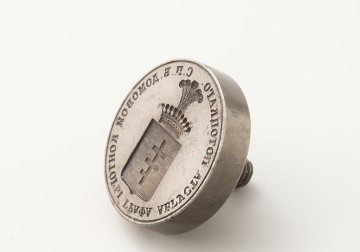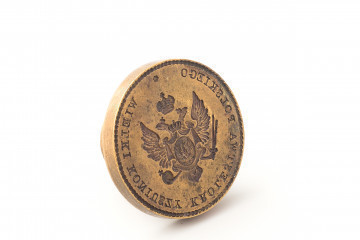
Seal matrix of the Church Administration of the Wilanów Parish
Museum of King Jan III's Palace at Wilanów
Part of the collection: Varia
In the collection of the Museum of King Jan III’s Palace at Wilanów, almost forty sphragistics pieces – seals or seal matrixes – have survived. The term ‘sphragistics’ is derived from the Greek word ‘sphragis’ standing for a seal (alternatively called sigillography after the Latin word ‘sigillum’) and defines the branch of auxiliary historical sciences where research focuses on interpreting the meaning of seals and determining the circumstances of their creation. The history of sphragistics dates back to the 19th century; at that time, it was noticed that seals could serve as a valuable source material contributing knowledge on political, heraldic and diplomacy arrangements as well as other motifs concerning the past.
The set of seals and seal matrixes preserved in the collection of the Museum dates back to the 18th century. Seals and matrixes are connected not only with the Wilanów estate. The set contains objects that can be associated with specific persons – the owners of Wilanów in the context of posts held by them, but also objects that document the system of administering estates and their functioning, not only the Wilanów estate.
The seal matrix shown here is an ink seal matrix (other matrixes can be used for lacquer seals). Its part containing the image to be impressed, in the shape of a circle, is concavely engraved (i.e., the impressed image is cut into the surface). The small handle of the seal matrix has the shape of a flattened roll and consists of a wooden shaft in an iron & metal sheet frame. In the seal field, there is a Swiss escutcheon (the term defines its shape) divided vertically into two equal parts. In one field there is the Szrenawia without a Cross emblem in the shape of the reversed letter S symbolising the course of the river, and in the second field there is the Pilawa emblem – two and a half of a cross. The escutcheon is topped with a nine-stick count’s crown with a plume of five ostrich feathers. Both emblems are compositionally supplemented with background motifs: an unbuttoned creased ermine coat behind Szreniawa and panoplies (arranged parts of armament, including sabres, three banners and a cannon barrel) behind Pilawa. Below, two four-armed order crosses hang on ribbons. The seal matrix probably dates back to the period when Aleksandra née Lubomirska (1758 or 1760–1831) and her spouse Stanisław Kostka Potocki (1755–1821) became owners of the estate.
Author / creator
Dimensions
entire object: height: 1,9 cm, width: 4,5 cm
Technique
carving,rolling
Material
brass,wood
Owner
Museum of King Jan III's Palace at Wilanów
Identification number
Location / status

Museum of King Jan III's Palace at Wilanów

Museum of King Jan III's Palace at Wilanów

Museum of King Jan III's Palace at Wilanów
DISCOVER this TOPIC
Museum of King Jan III's Palace at Wilanów
DISCOVER this PATH
Educational path